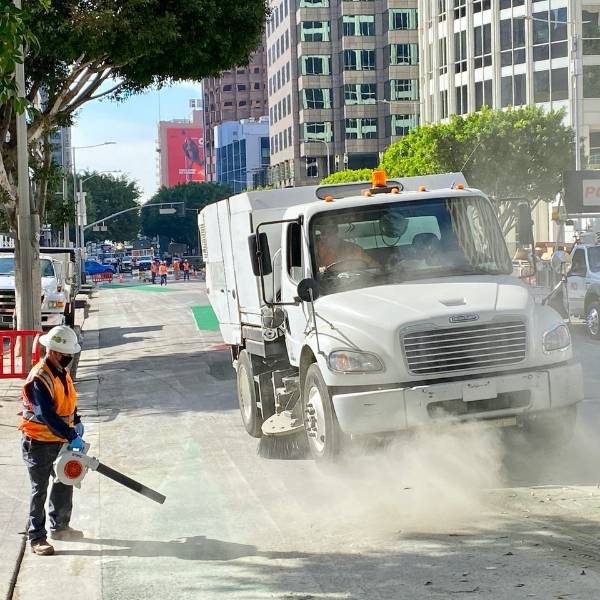By Bryn Lindblad
Shortly before I was born, my uncle died from an asthma attack—that certainly didn’t help. I feel in the way that my family talks about Uncle Barry just how precious his life was. And then I read in the headlines that one out every five lives that ends prematurely is due to air pollution caused by the burning of fossil fuels, and I can’t help but feel like the social contract we’re living within is letting us down. It’s not doing enough to value life.
I live in the U.S.’s most polluted metropolitan area; Los Angeles’ air quality is the worst of the worst. We go for months on end sometimes when there’s not a day that’s considered “safe” by federal air quality standards. Because I want to be part of the solution, I choose to bike around town—even though I do so with a lingering fear that every breath I’m taking is harmful to my health.
At Climate Resolve, we realize that systems change is needed, and also that individual actions can create the momentum that is needed to achieve those big picture shifts. When it comes to air pollution, here are fifteen things that you can do to protect your health and be an agent for change for cleaner air:
Get by

- Avoid strenuous physical activity outside when the air quality is bad. Usually that’s mid-day and in the late afternoon, when it’s hottest outside. I know, it’s a total bummer and not fair that when kids are getting off school for the day and have some extra energy to burn that we’re telling them to not be active. But, exercising in bad air pollution can damage our respiratory health and trigger asthma attacks. Kids’ airways are especially susceptible to harm from air pollutants.
- Check an air quality map to know when air pollution outside is unsafe. My favorite one is called PurpleAir; I like that it displays lots of local air quality readings so that you can get a real-time understanding of what the air around you is like. If the air quality sensor nearest you is orange or red, then take it easy on your lungs. If there’s not a readout on that map that’s near you, then volunteer to host an air quality sensor on your wifi network. As long as you’ve got an outdoor outlet that it can plug into, you can sign up to host a sensor through the Coalition for Clean Air’s CLEAR program. Gap areas that could use some sensor hosts include: Inglewood, Hawthorne, Compton, Carson, San Pedro, Long Beach, Downey, Norwalk, Covina, Whittier, La Habra, Corona, Fontana, the San Fernando Valley, Santa Clarita and more.
- Wear a pollution mask if you’re going to be outside exercising in polluted air, like I do when I bike around town. It looks kind of like the masks we’ve all gotten used to wearing for Covid, except pollution masks have some valves that make it a bit easier for you to exhale.
- Get your prescription inhaler refilled and carry it with you if you or a loved one has asthma—one in ten kids has asthma; in Los Angeles, one in four black kids has asthma. Your inhaler sure doesn’t do you much good if it’s empty or at home.
Breathe Easy Inside

- Install an indoor air filter to make sure that the air quality inside your home and place of employment is alright. Cooking, pets, dust, smoke, gas-fired furnaces, and aerosol cleaning products are just some of the sources of poor indoor air quality. To eliminate those irritants, install an air filter that’s powerful enough to clean the air for the size room that you’re in. Each room might need a separate air filter. Prioritize the rooms that you spend the most time in.
- Eliminate sources of mold and mildew, since they put out spores that can be really bad for respiratory health. Make sure to air out humid areas, like a steamy bathroom, and proactively address water damage issues, like a leaky roof or rain drainage problems. If you’re renting the place that you live or work and it has mold or mildew, be assertive and report it to your landlord immediately. If they don’t act on it, seek out a tenants rights organization to help you stand up for your rights to a healthy living environment. The law takes this one pretty seriously, and so should you.
- Breathing exercises can be good for mental health, hypertension, and they can also help you maintain or recover good respiratory health. It might seem a little woo-woo, but it’s legit. Slow and deep breathing exercises can help you train your diaphragm to do its job, and there’s even instruments out there, like one called a spirometer, which you can use to build up your lung capacity.
Cut pollution at the source

- Replace gas-powered gardening equipment, like leaf blowers and lawn mowers, with electric versions. Did you know that gas-powered leaf blowers have been illegal in LA since 1998? Nobody wants to be a Karen and report them, though, and so they’re still pretty commonplace and polluting our local air. When you encounter people using gas-powered gardening equipment in your neighborhood, consider sharing information about rebate programs that subsidize the cost of electric gardening equipment if the person trades in their old polluting version.
- Enough with the idling vehicles already. If there’s a pick-up area where cars often leave their engines idling, such as near a local school or a popular take-away restaurant, consider putting up signs that ask people to cut their engines for the sake of your respiratory health.
- Advocate for electrifying vehicles, especially diesel engines that are particularly bad for local air pollution. Contact the LAUSD school superintendent to let them know that electrifying diesel school buses is a top priority for you. Contact your state assemblymember, too, to ask that they pass regulations and incentivize the near-term phasing out of diesel trucks, so that those aren’t polluting our neighborhoods anymore either.
- Ask for traffic calming changes to your local streets, such as roundabouts and slower speed limits. A lot of local air pollution is created by rapid acceleration, when people really put their foot on the gas pedal, which happens often after someone has just stopped their car at a stop sign or red light. So have an open mind and ask your City Councilmember to deliver a roundabout at your local intersection, which could even include some plant life. Slower speed limits are also a way to smooth out traffic and cut some of the pollution that comes from fast accelerations.
- Drive less, and demand better public transit options, a network of safe bike lanes, and shaded sidewalks. Electrifying cars and calming traffic only gets us part of the way to better air quality, and that’s because not all pollution comes from the tailpipe. In fact, about half of the pollution from cars comes from tire and brake debris, and I’m sorry to say, but electric cars create that tire and brake dust pollution, too. We need to tell our Mayor and City Councilmembers that we want investments in non-car mobility options so that Angelenos can do the right thing and not drive as much.
- Plant plants, and advocate for more trees and greenery in public spaces, including streets, plazas and school play yards. Plants help filter pollutants out of the air, and they also cool down local air temperatures. Since heat is a major factor behind ground-level ozone formation, which is polluting much of LA, when we cool down our urban environment, we can help counter that trend. If you’ve got a patch of barren or paved-over earth that you can turn to greenery, make that desert bloom (with drought-tolerant plants)! Your local community garden may have a seedling giveaway program, and in the City of LA, there’s a program called City Plants that gives away free trees to plant on private property. City Plants also has a program to plant trees in empty tree wells along sidewalks, so long as a nearby resident agrees to water it. To get our public spaces to contain more greenery, let your Mayor and City Councilmember hear from you that you want them to plant more streets trees, incorporate more greenery into street medians, plazas, and school play yards, and that you want people to have good, public sector jobs to maintain that greenery.
- Install a cool roof the next time that your roof needs redoing. These more reflective roof coverings help you save money on your electric bill by not needing to run the air conditioner quite so much to keep your home cool, and they also cut back on waste heat, helping to keep the neighborhood air temperature cooler. Those cooler temperatures slow the formation of ground-level ozone, LA’s most persistent air pollutant, and the cooler temperatures also benefit student performance, reduce workplace injuries, heat fatigue and heat stroke. The cost of cool roofs is on par with conventional roofs, and so there’s really no reason not to go for the cool option.
- Advocate for cool pavement and smog-absorbing materials, especially on streets where pollution is particularly bad, such as near freeways. Similar to cool roofs, cool pavement is a reflective coating that goes atop our asphalt roads to make them radiate less heat into our urban environment. This cooling not only cuts ozone pollution (since heat is a major factor behind ozone formation), but it also reduces tire debris particulate matter, since tire wear-and-tear happens more on hotter roads. Additionally, cool pavement reduces asphalt off-gassing, which is a significant source of air pollution during hot weather. The titanium dioxide that’s used to make cool pavement more reflective also has smog-absorbing properties. Street furniture, such as bus shelters, traffic signals and traffic signs can be treated with a smog-absorbing coating that removes air pollutants from street level air. Let your Mayor and City Councilmembers hear from you that you’d like to see more cool pavement and smog-absorbing materials installed in your neighborhood.
We’ve got a lot of tools in our toolbox. As climate change ratchets up temperatures, which makes already bad air quality worse, it means we’ll have to start using those tools more and more. It wasn’t enough to just install catalytic converters on cars and reformulate gasoline mixes. The work must go on to create a clean air future, and there’s a role for all of us to make that happen.








